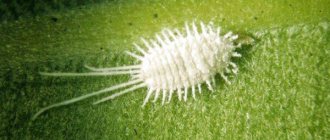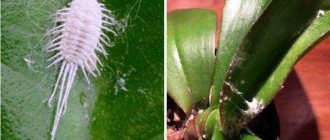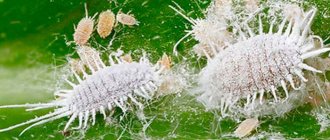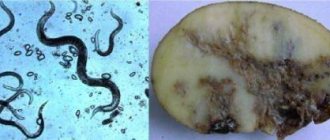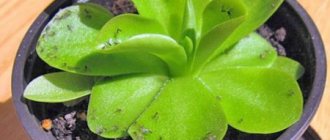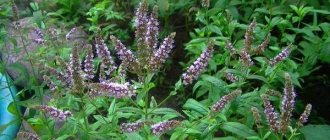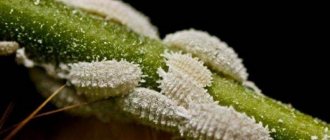Mealybugs on orchids are not very mobile pests. They are tiny and resemble little cotton balls. On orchids they hide in the corners of leaves and in dormant buds.
They suck the juice out of plants. The leaves of attacked flowers turn yellow and fall, the plant stops growing. As a result, even large specimens of orchids die after some time. We'll tell you how to deal with it and how to treat the plant.
Mealybug on an orchid
Houseplants are dying - the cause is mealybugs!
Mealybugs are very nasty pests.
They attack indoor flowers. As a result, they develop poorly and have an unsightly appearance. These insects are popularly called “hairy lice” because of the large number of bristles and hairs on their oval body. The presence of the parasite reveals a white coating on the leaves. And the scale insects themselves are visible to the naked eye. You need to get rid of them immediately, because very soon they will spread to all the surrounding plants. Therefore, consider the following question: “If there are mealybugs on indoor plants, how to deal with them?” What is a mealybug?
The appearance of this pest cannot be confused with anything. This is a fairly large relative of the scale insect. The mealybug reaches up to 8 mm in length. Female “hairy lice” have an undeveloped oval-shaped body, more typical of insect larvae. They lay numerous eggs in special sacs in the axils of the leaves. The shoots on which the pest lives are covered with a white, sticky waxy coating. Males are not at all similar to females - they have wings and normally developed limbs, the body is divided into sections and ends in a bunch of tail filaments. With the help of their oral apparatus, females and larvae easily pierce the surface of a leaf, bud or shoot and suck out the juices from it. Young scale insects are extremely mobile and easily move between plants. Sexually mature males do not feed because their mouthparts atrophy as they grow older.
Signs of Mealybug Infestation
To detect pests, it is enough to carefully examine the indoor plant.
Main features:
- drooping look
– lethargy of leaves and shoots;
– underdeveloped buds,
– deformed leaves;
– white powdery coating with lumps;
– small “mosquitoes” (male scale insects) on the windows near the pots;
– the presence of sticky mucus (honey dew) on all parts of the plant;
– the presence of white inclusions in the earthen coma during transplantation;
– presence of white oval insects.
Any of these symptoms may indicate the appearance of a scale insect. Not a single flower is immune from infection. Special control should be given to citrus, amaryllis, cycad and palm plants, as well as cacti, violets and orchids. Often suffers from the azalea pest. The pest attacks young shoots. The leaves stop growing and begin to turn yellow. An azalea affected by insects loses its former appearance. Harm to the plant Mealybug literally pulls all the nutrients from the flowers, disrupting their growth and normal development. Sweet honeydew secreted by females provokes the development of associated fungal infections. Due to the sticky, impenetrable coating, the green pet's breathing becomes worse. This can cause the leaves to wilt and even fall off. Mealy aphids (another name for mealybugs) do not prefer a specific part of the plant, attacking everything that comes in its way. Not only shoots, buds and leaves are under attack, but also roots. If treatment is not started as soon as possible, the bug will spread to surrounding indoor plants. In time he will destroy them all. Therefore, it is necessary to immediately declare war if you notice mealybugs on indoor plants.
Causes of mealybugs
Why do these harmful insects appear?
There are several main reasons:
Presence of eggs and larvae in the soil.
Even purchased soil can be contaminated, so it is very important to treat it with hot steam before use.
Transfer of larvae with newly acquired plants. New pets should be kept separately and carefully examined periodically. You can place them next to other flowers only after finally making sure that there are no pests.
Errors in care - low room temperature, stagnation of moisture in the soil, insufficient lighting, excessive application of fertilizer. Improper care significantly reduces the plant’s immunity, causing various diseases.
The presence of dust on the leaves, irregular removal of dry parts. Untimely replacement of soil in pots. Harmful insects can live inside a compacted earthen clod.
Poor quality water for irrigation.
Measures to combat the mealybug
If white lumps are found, you need to wipe or wash the plant in a soap-alcohol solution (dissolve one teaspoon of finely chopped laundry soap in 1 liter of hot water, add 2 tablespoons of vodka), you can use a solution of dishwashing liquid. Rubbing the leaves with alcohol or vodka also helps. All these available means weaken the waxy coating of scale insects, which makes them more vulnerable to pesticides. Before treatment, all visible pests must be removed with a cotton swab or toothbrush. The cotton swab must be changed, and the brush must be thoroughly washed and treated with alcohol or detergent, so as not to transfer the bug to other parts or neighboring plants.
After the “mechanical” treatment, it is imperative to proceed to the “chemical” treatment. To do this, you can use insecticides: golden spark, fitoverm, actellik, phosphamide, intavir, fufan, metafos, actaru, karbofos, mospilan.
- actara for mealybugs: dissolve 4 g of the drug in 5 liters of water for watering and spraying;
- tanrek for mealybug: 1.5 ml per 5 liters of water for spraying or 1.5 ml per 2.5 liters of water for irrigation;
- Apache from mealybug: 1 sachet (0.5 g) per 2.5 liters of water for spraying or 1 g per 1 water for irrigation;
- Confidor for mealybugs: dilute 2 ml of the drug in 5 liters of water for spraying or 2 ml in 2.5 liters for watering;
In addition to spraying with the same solution, you need to spill the soil in the pot. Such treatments will have to be repeated more than once; it is best to change the drug each time. It is assumed that the bug very quickly gets used to one drug and develops immunity. It should also be noted that it is difficult to fight the scale due to its waxy coating. If you simply, upon discovering a bug on a plant, immediately treat it with an insecticide, you will not always be able to achieve the desired result. The insects or their larvae (egg sacs) need to be disturbed - with a stick, brush, cotton wool, and their protection - the wax shell - is weakened, only then the insecticide can act on them. This complex treatment is carried out every 4-5 days. With less frequent processing, no measures help.
The fight against scale insects is not quick and lasts up to six months.
If damaged by root worms, the soil is completely changed. The pots are thoroughly washed in hot water with a disinfectant. The roots of the plants are carefully examined, washed in running water and completely placed in a solution of any insecticide for 15 minutes.
The plant needs to be transplanted into fresh, moist soil, carefully watered with water, and after a week - with an insecticide solution. But even after this, make it a rule to carefully examine the plant so that at the first discovery of white lumps, you can resume the fight against them.
As a pest prevention method, when replanting a plant, you need to carefully examine the roots. If pests are found, disinfect the pot (scald with boiling water), carefully clean the roots from the old soil, wash the plant roots in an insecticide solution and plant in fresh soil. If it is not possible to replant the flower, you need to water the soil with systemic insecticides that penetrate the vessels of the plant and cause the death of pests - these are actara and confidor.
Actara should be diluted as follows: 1 g of the drug per 10 liters of water. If you decide to replant, immerse the root part of the plant in the solution and soak for 5-7 minutes. If you have neither actara nor confidor, you can use any insecticide, for example, actellik, decis, karbofos. If the root system of the plant is fibrous, densely entwined with an earthen ball, then you need to prepare a solution and immerse the plant in it for 20 minutes (roots). Then dip into the solution several times along with the leaves. Leave to sit for 5-10 minutes, then rinse the plant under a warm shower.
What types are most common?
Bristly
Externally, such a parasite has an oval body shape with a slight elongation. The color is slightly pinkish or orange with a characteristic white coating. The last pair of ventral setae is longer than the others. A large accumulation of bristle bugs can be observed on the back side and in the axils of the leaves, on the branches of the plant. Belongs to a viviparous species.
Grape
The female has an inherent broad oval shape. This species of mealybugs is most attracted to subtropical climates. Pink or yellow color belongs to this species. The whole body has a coating. It is extremely rare to find males in grape bugs. The emerging larvae occupy the entire plant from shoots to leaves, or rather their main veins. Excretion from scale insects leads to the appearance of sooty fungi in these areas.
Seaside
The most harmful and at the same time common type. The color is gray-pink with a whitish coating. The seaside mealybug has well-developed limbs, which facilitates their rapid movement throughout the plant. Unlike the females of this species, males have wings and move in space throughout the summer.
Females lay offspring in difficult-to-reach places, for example, in the bark of trees, up to 350 - 400 eggs. A feature of the larvae is the absence of a white coating on the body. Seaside mealybug larvae develop into adults within one month.
Citrus
The color of this species is very diverse - from brown to slightly yellow. Female citrus bugs secrete honeydew, i.e. sweet secret. The males of this species, like the seaside scale insects, are capable of flight. The color of males is often pink or yellow.
Mealybug: getting rid of it effectively!
Mealybugs, which attack indoor and greenhouse flowers, as well as berry plants and fruit trees, are the main problem for many flower growers and gardeners. This flower vampire literally sucks all the life force out of plants. They are stunted in growth, covered with a white cobwebby coating and quickly fade. Meanwhile, the colony of pests grows and moves from a dying flower or bush to a neighboring, completely healthy one.
How to stop the army of these voracious invaders? Folk remedies are used quite effectively to destroy scale insects. And insecticides are resorted to only in case of a large number of pests or the ineffectiveness of the previous method.
Popular means of struggle
If there are a lot of pests, it is better to immediately resort to drastic measures - insect killers known on the market. Timely treatment with insecticides will save the flowers and save the nerves of the owners.
All work with chemicals is carried out only with rubber gloves and a respirator!
Aktara
"Aktara" is a complex drug used to control many pests.
The insecticide solution is applied to the diseased plant using a spray bottle or poured into the soil at the base of the stem. Spraying provides protection for up to four weeks. The active substance lingers in the soil a little longer, up to two months. When sprayed insecticide
acts in 20–30 minutes, reducing appetite and causing disruption of the digestive system.
To prepare a solution, take 1-2 g (for spraying) or 8 g of the drug (for watering) per 10 liters of water. This ratio is used when working with indoor plants.
When processing vegetable and garden crops, milk is first prepared (1 packet of product per 1.5 liters of water). To spray currants you need 250, and to treat flower beds 600 milliliters of milk.
- effective in most cases;
- compatibility with pesticides;
- low toxicity to earthworms and birds.
- addictive to pests;
- toxic to bees.
Aktofit
"Aktofit" contains a natural toxin that is dangerous for many types of garden and garden pests, including scale insects.
The active substance affects the nervous system, causing paralysis. The death of sucking insects occurs eight hours after spraying.
Processing is carried out at temperatures above +18 degrees. Optimal temperature indicators are +28 degrees. To obtain a solution, 4–12 milliliters of the drug are dissolved in a liter of water.
- does not pollute the soil;
- is not addictive;
- compatible with fertilizers and other insecticides;
- One or two treatments are enough.
- the drug is not effective at temperatures below +18 degrees;
- dangerous for bees.
Akarin
"Akarin" belongs to the group of biological drugs.
After spraying, the active substance penetrates the digestive system of pests, causing acute poisoning. After just eight hours, the mealybugs lose activity and stop feeding. Pests die on the second day after treatment.
To prepare a solution, 2 or 5 milliliters of the product are diluted in a liter of water. Plant leaves are wetted on both sides. The insecticide can be used several times a season, with an interval of 2-3 weeks.
- is not addictive;
- non-toxic to earthworms and birds;
- compatible with pesticides and other insecticides;
- used at temperatures from +12 degrees and above.
Disadvantages: dangerous for bees.
Fitoverm
“Fitoverm” is a preparation created on the basis of waste products of soil microorganisms.
Sucking pests lose activity sixteen hours after treatment and die on the second day.
The active substance affects the digestive system of insects, reducing appetite and causing acute poisoning. The effect of the drug is from one to three weeks.
To obtain a solution, 4 milliliters of insecticide are mixed with two liters of water, and then the resulting mixture is diluted to the required volume. It takes 100–500 milliliters of solution to treat a medium-sized indoor plant. In greenhouses and outdoor flower beds, the consumption is 10 liters per 100 square meters of area. Treatment can be carried out at intervals of two weeks.
- does not pollute the soil;
- completely breaks down into safe elements in the soil;
- Compatible with fertilizers and growth regulators.
- not effective in rainy weather;
- dangerous for bees.
Mospilan
"Mospilan" is a contact drug used to combat many types of insect pests.
Penetrates into plant sap, so it is effective even on untreated areas of stems and foliage. Affects all ages of pests: eggs, larvae and adults. The active substance, entering the digestive system of an insect, causes paralysis. An hour after treatment, insects lose activity and die on the second day. The protective effect lasts two to three weeks.
To obtain a solution, 2.5–5 grams of the drug are stirred in a liter of water. Then the resulting milk is diluted in a bucket of water (10 l). This amount of solution is enough to treat an area of 250 square meters.
- non-toxic to plants;
- compatible with fertilizers and other preparations.
- not effective at low temperatures;
- toxic to bees.
Fufanon
"Fufanon" is a complex action drug used against many insects.
Affects the nervous system of pests, causing death within two to three days. Emulsion concentrate in an amount of 10 milliliters is mixed in 10 liters of water. Two or three treatments per season are allowed. The interval between spraying is three weeks. If vegetables have been processed, they should not be eaten for 20 days.
- non-toxic to plants;
- effective at temperatures above +12 degrees.
- toxic to bees and fish;
- does not mix with other drugs.
Phytoseiulus is a predatory mite that feeds on pest eggs. Read more about this beneficial insect in the article.
“Sunmite” is a popular drug that is designed to combat ticks that feed on agricultural crops. You will find detailed information about this acaricide at https://stopvreditel.ru/rastenij/borba/akaricidy/sanmajt.html link.
Folk remedies: soap-alcohol solution
A soap-alcohol solution is a frequently used folk remedy to combat mealybugs.
A teaspoon of crushed laundry soap is dissolved in water, then the amount of solution is increased to a liter. Add a tablespoon of alcohol or two tablespoons of vodka.
The plant is sprayed, while the soil underneath is protected with film or a piece of cellophane.
The next day, the soap must be washed off with clean water. Treatments are carried out at intervals of three days until the scale insects completely disappear.
Where do mealybugs come from?
Mealybugs are small insects a few millimeters long. They have a soft, segmented body covered in a white or pinkish covering that resembles wool or cotton.
May enter through windows and ventilation networks. Get on plants that are placed on balconies and terraces in summer. You can bring them home when you buy exotic plants. Most of the time they remain inactive - skillfully hiding in the corners of leaves, in flower buds or in the soil. When external conditions become favorable for them - air humidity decreases and temperature rises - they begin to feed. This is why mealybugs usually appear on orchids in winter during the heating season.
Variety of scale insects
There are currently 3 types of mealybugs:
- bristly;
- grape;
- seaside.
Bristly. The body of an adult female is 3.5 mm. It has the shape of an elongated oval, the color is unusual - pinkish or orange. And also the whole body is covered with a white coating. The legs are well developed, it is thanks to them that insects can easily move from one plant to another. Parasites are viviparous. Often these scale insects form a column and are located on the underside of the leaf. They can be found in the axils of leaves, on young tops and shoots.
This type of insect is large and easy to notice on the plant due to its white coating. Leaves that are exposed become damaged and turn yellow over time. All shoots do not die, but at the same time they stop growing. Plants that have been attacked by these insects are very retarded in development.
Grape. The female has an oval body shape, yellow or pink coloring. The legs of the individual are well developed. It is very difficult to meet males; they are very rare. The larvae that are born are located throughout the plant, on shoots and leaves. When the worms manage to attach themselves to the plant, they create a huge colony that sucks all the juices out of the plant.
Representatives of the female sex are engaged in laying eggs in a special pouch. Females often hide from public access; they look for secluded places to hide their eggs. The larvae emerge small and very mobile, their color is yellowish. The larva is completely devoid of waxy coating. When an insect lands on a plant, it spreads throughout it very quickly. This type of scale insect is carried by the wind and is a pest for people and animals.
Mealybug on an orchid - photo
Before purchasing a plant, carefully inspect the selected specimen for the presence of pests or symptoms of their presence. On orchids, the scale insect usually sits on the outside of flowers and flower shoots, in places left over from fallen flowers and leaves. They form clusters that can look like the pattern of petals on flowers.
Mealybug on an orchid
Mealybug on an orchid
During feeding, insects secrete honeydew, which is a breeding ground for fungi. Therefore, often a weakened plant also suffers from fungal diseases.
After purchasing a new orchid, make sure that it does not quarantine with other flowers. Place it away from other flowers, do not unwrap it, and keep an eye on it for bugs or other pests.
How to fight
If you observe individual orchids on the leaves and shoots of a flower, remove them as gently as possible so as not to damage the tissue with a cotton swab. The tampon is soaked in an aqueous solution of sulfur soap, denatured alcohol or 40% alcohol with water (1:10 ratio) with the addition of a few drops of dishwashing liquid. Washing the above-ground parts of the plant with vinegar is also effective.
Use a clean cotton swab each time to avoid transferring the pest. In order for the treatment to be successful, you need to wash the entire plant (all leaves and inflorescences). Flowers, unfortunately, must be removed.
Insecticides
Washing orchid leaves using cotton swabs is a tedious job and will only be effective if individual insects are present. In the event of a massive appearance of pests, you need to spray insecticides. Actellik and Confidor are suitable for this purpose . The plant should be sprayed with liquid and wrapped tightly in a plastic bag. Leave the orchid like this for several hours. Treatments should be repeated every 7-10 days. Sometimes mealybugs may also feed on plant roots. This can be checked by removing the root from the pot. In this case, the plants are watered with a diluted preparation.
Washing plants in the shower
If plants with large leaves are affected, washing with a cotton swab is a rather tedious and time-consuming task. In this case, rinsing the plants with a strong stream of hot water will help. The plant must be thoroughly washed on each side to wash away all pests.
The main problem is insects that feed on plant roots. If we notice their presence, we need to remove the plant from the pot and rinse its roots with running water. Then plant the plant in a new substrate and a clean pot.
A good way to get rid of mealybugs is to immerse the flower and roots in water at 55°C for about 30-45 minutes . To increase the effectiveness of treatment, you can add dishwashing liquid to the water (2-3 tablespoons of liquid for 10 liters of water). After washing in water and dish soap, the plant should be rinsed thoroughly.
Lubricating leaves with paraffin oil
Another control method is to lubricate the leaves and stems with paraffin oil.
Paraffin oil is available in pharmacies. To prepare an effective preparation based on paraffin oil, you need to mix it with water (1:1 ratio), adding a few drops of dishwashing liquid.
Mix all ingredients thoroughly until a homogeneous mixture is formed. Then, using a soft brush, apply the product to the affected areas and into all cavities in the stem and leaves of the plant. The oil prevents air from entering and the pests die. After a few days, rinse the plant thoroughly with warm water in the shower. We need to repeat the treatment every time we notice pests on the plants.
Fitoverm for mealybug
This is an insecticide of biological origin. It paralyzes pests, which leads to their death. Fitoverm is effective not only against mealybugs, but also against aphids and scale insects.
To treat an orchid, you need to dilute 1 ampoule of the drug in 200 ml. water. The treatment must be repeated after 2 days. For effective pest control, 4 treatments are necessary. The insecticide is harmless to the plant; after 24 hours it completely decomposes. But this is also its disadvantage. To get a good effect, it is necessary to carry out several treatments with an interval of 2 days.
Unfortunately, mealybugs often reappear on orchids. To prevent the appearance of pests, create unfavorable conditions for them. The most important thing is to maintain high humidity in the room.
Whitefly
Whitefly is a pest that attacks not only indoor flowers, but also garden plants. Many farmers are faced with the activity of this pest and note that the plants very quickly become weakened and dry out.
The butterfly is microscopic in size and, as is clear from the name of the pest, is white in color. One of the most characteristic signs of a whitefly attack on orchids is yellowing and drying of the leaves. Flying from plant to plant, the parasite deposits its larvae in the root system, on the back of the leaves, and in more advanced cases they can be seen on the top.
However, the whitefly rarely attacks phalaenopsis because it prefers thinner-leaved plants. Infection can occur from an orchid of another species, for example, dendrobium or oncidium. However, the fight should be aimed at destroying the entire population: both adults and larvae.
Treatment
It is important to carry out treatment comprehensively, using several techniques at once. It is recommended to treat the plant with household chemicals, as well as preparations:
- The orchid should be washed with a solution of laundry soap using soft rags or cotton swabs.
- After destroying the bulk of insects, the leaf part and substrate are treated with a solution of drugs of your choice: Fitoverm, Aktara, Vermitek.
Since the most optimal environment for whiteflies is high humidity and extremely high temperatures, the best prevention will be to optimize the conditions for keeping the orchid.
How to deal with mealybugs on indoor plants: a review of effective remedies
Ornamental plants in neat pots can become the main decoration of any interior, while some of them bloom for a long time, which only enhances their aesthetic characteristics. However, sometimes troubles happen, for example, when flowers suddenly become covered with a whitish coating and begin to fade. This indicates an attack by a dangerous parasite - the mealybug. What affects the appearance of this pest, and how to deal with mealybugs on indoor plants?
Characteristic
Mealybugs are pests of ornamental crops that feed on plant juices. They have an oval body covered with a whitish, waxy coating, which can form a dense, uniform layer or be located in separate teeth. Depending on the species, the body of the parasite will be pinkish or grayish. The size of an adult can also vary - from 3 to 7 mm.
The mealybug gets its name from a substance that the pest produces itself. Initially, it is a sticky mass, which after some time becomes covered with a whitish fungus. Outwardly, it looks like a small ball of cotton wool, under which the parasite or its clutch is usually found. If you do not figure out in time how to remove mealybugs and do not start treating the plants, then over time the plaque will spread throughout the stem and foliage, which will seriously interfere with gas exchange and may lead to the death of the flower.
Gentle means for killing parasites
If the plant has been infected with mealybugs, then it is initially advisable to try gentle folk remedies. When there are few pests, such homemade preparations often show excellent results.
Before using solutions, it is necessary to manually collect all the parasites that were found and cut off damaged shoots and leaves. Next, we wash the plants with running water, paying special attention to the lower surface of the leaf blades. Now you can proceed to processing. What is used for this?
- Soap solution with added alcohol. This is a very effective remedy for mealybugs, which is also easy to prepare. We take ordinary laundry soap, rub it on a fine grater (we need one teaspoon) and dissolve it in a small amount of hot water. Fill the volume of the soap solution with water to 1 liter, pour in 15 ml of alcohol or 30 ml of vodka. Mix and spray the above-ground parts of the plants, after covering the soil with a plastic bag. The next day, wash the flower with warm water. Treatment with a soap-alcohol solution must be repeated several times at three-day intervals.
- Garlic infusion. Pass a few cloves of garlic (50-70 g) through a press and add a liter of boiled water. Leave the mixture for 6-7 hours, or overnight, then filter and spray the affected flowers.
- Pharmacy tincture of calendula. This is the easiest remedy for mealybugs since you don’t need to cook anything. Take a pharmacy tincture, soak a cotton pad in it and wipe the affected areas very thoroughly. The treatment must be repeated 2-3 times and is best done in the evening.
Important! During treatment with calendula tincture, the plants must be moved to a shaded place!
Preventative treatment
To prevent scale insects from settling on plants, you must remember the following preventive measures:
- Carry out regular inspection of the bushes, paying special attention to leaf axils, the underside of leaves and buds.
- Trim or tear off dried stems, buds, leaf blades and branches in a timely manner, as they can attract harmful insects.
- Water crops properly. Watering should be systematic and sufficient.
- It is very useful for indoor plants to have a warm shower.
- Any new indoor flower is quarantined for at least 15 days. To do this, it is removed away from other house plants and must be sprayed with an insecticidal solution for preventive purposes.
The most favorable environment for scale insects is warmth (above 25 degrees) and high air humidity. If your flower is grown in such conditions, then you need to inspect it regularly to identify insects.
Use of insecticides
The use of insecticidal preparations for mealybugs is recommended in cases where there are a lot of parasites or folk remedies have proven ineffective. They will have to be applied twice with an interval of 10-15 days. This is necessary in order to destroy the larvae that emerge from the eggs.
- "Confidor". A systemic insecticide that copes well with pests of indoor plants when other drugs have not brought a positive result. Moreover, its effectiveness is at the proper level even in cases where the parasite has settled in the rhizome. Has intestinal contact activity. The working solution, which is prepared from 1 g of the drug and 10 liters of water, is sprayed on the above-ground parts of the infected specimens and the soil is additionally shed. If the infection is serious, then the working solution is made more concentrated - 1 g of the drug per 5 liters of water.
- "Aktara" is a complex drug that helps get rid of a wide range of pests, including mealybugs. Shows high efficiency both when sprayed and when added to the substrate. Half an hour after treatment, the parasites lose their ability to feed and die within 24 hours. This product is compatible with many insecticides, fungicides and growth regulators. How to dilute the drug "Aktara" against mealybugs: at a concentration of 250 g/kg - 1 g of product per 10 liters of water; at a concentration of 240 g/l - 1 ml of product per 10 liters of water. The prepared working solution is poured onto the soil under the infected plants.
- "Aplaud." An insecticide that comes in the form of a wetting powder. Characterized by contact-intestinal activity. The main active ingredient is buprofezin, which interferes with the normal synthesis of the chitinous cover of the pest, which is why the larvae do not molt. As a result, they die. The working solution is prepared from 1 g of the drug and a liter of water. The components must be carefully moved and used to treat plants. Effectiveness does not appear immediately - the death of parasites is noted within a week. It can be used together with synthetic pyrethroids and organophosphates, and does not cause resistance in pests.
- “Fitoferm” is a biological preparation that perfectly protects plants from mealybugs. It is based on the waste products of soil microorganisms and exhibits an intestinal contact effect. Penetrating into the pest’s body, the active components of the product affect its digestive system, as a result of which it gradually loses its ability to feed and dies. The drug exhibits activity within one to three weeks from the moment of treatment.
- "Mospilan" is a systemic insecticide that exhibits contact-intestinal activity. Based on acetamiprid. Once on the leaves and stems of the plant, the active substances are immediately absorbed and evenly distributed throughout the plant’s body. Thanks to this ability, even those areas that have not been properly treated receive protection. Parasites die upon contact with the toxic substance and when sucking out the juices of the treated plant. The result of the drug can be observed within an hour after spraying: the parasites experience a lack of coordination of movements, as a result of which they lose the ability to stay on the underside of the leaves.
Important! When using the drug "Mospilan", the plants must be placed in the shade, since if they are exposed to sunlight, burns may occur!
It is advisable to re-treat mealybugs with a drug based on a different active ingredient, since the pest may develop resistance - resistance to the poison.
Important! The organophosphorus insectoacaricide "Actellik" can be used to treat indoor plants only if they are located outdoors. The use of this product in a residential area due to its high toxicity is strictly prohibited!
Advantages and disadvantages
The drug has a number of advantages and disadvantages. Pros :
- Low level of toxicity.
- Pests do not get used to the product when used periodically.
- Economical consumption compared to analogues.
- Does not accumulate in the external environment, quickly disintegrates. When watering the soil, the drug will completely disintegrate within a day, on the leaves - after 3 hours.
- Highly effective at the initial stage of infection.
- Can be used at high temperatures and during orchid flowering.
- Quick effect.
- Does not affect the growth and flowering of orchids.
Minuses:
- Low efficiency when there is a strong spread of pests.
- Does not destroy parasite eggs.
- Repeated treatment is required to completely get rid of insects.
- It does not linger on the foliage, so the product is mixed with soap.
- High cost compared to analogues.
- You cannot combine treatment with Fitoverm and other drugs.
- It is dangerous for aquatic organisms, so the remaining solution should not be poured into the sink.
- Not safe for bees.
Note! Orchid flowers cannot be treated. If parasites are found on them, they need to be torn off.
Important Tips
Remember that during the treatment of infected specimens, you must be careful about watering them. Excessive waterlogging of the substrate can lead to rotting of the rhizome, and since the plants are already weakened, this outcome is observed in most cases. If parasites have settled in the soil and damaged the roots, then with abundant watering, a secondary infection may well penetrate through these wounds.
To protect your green “pets” from mealybugs, you need to regularly inspect them, especially in the off-season, when the central heating starts working. During this period, it is important to observe how the plant develops and whether white lumps appear on its leaves and stems.
Among indoor plants, the most susceptible to mealybug infestation are:
Take care of indoor plants, keep them clean, from time to time wipe the shelf or window sill on which they are located with a soap solution and remove fallen leaves in a timely manner. These simple recommendations will help protect potted flowers from attacks by mealybugs and other pests.
Prevention measures
To avoid the appearance of hairy bugs on indoor flowers, you need to practice prevention.
This means careful care, systematic inspection of the plant, and removal of dead leaves. Hairy bugs prefer very dry air, so you need to provide your green pets with plenty of bathing in the shower. It is useful to expose them to the sun more often, because for this type of pest, the effect of direct sunlight is destructive. Special attention should be paid to flowers in the off-season
In large premises - greenhouses and conservatories - a so-called biological control method is used. Other insects inhabit there, for which mealybugs are their favorite food. For example, Australian ladybugs or the larvae of the common lacewing. Such measures are quite effective and help destroy harmful insects.
The causes of mealybugs are primarily a weakened plant. If you provide indoor flowers with good care, then no treatment or control of harmful insects will simply be needed.
Mealybugs
- sucking pests of indoor plants, close relatives of scale insects. Popularly called hairy lice.
The official name was acquired due to the whitish, waxy discharge resembling cotton wool.
Belongs to Homoptera
insects of the suborder
Coccid
, family
Coleoptera
.
